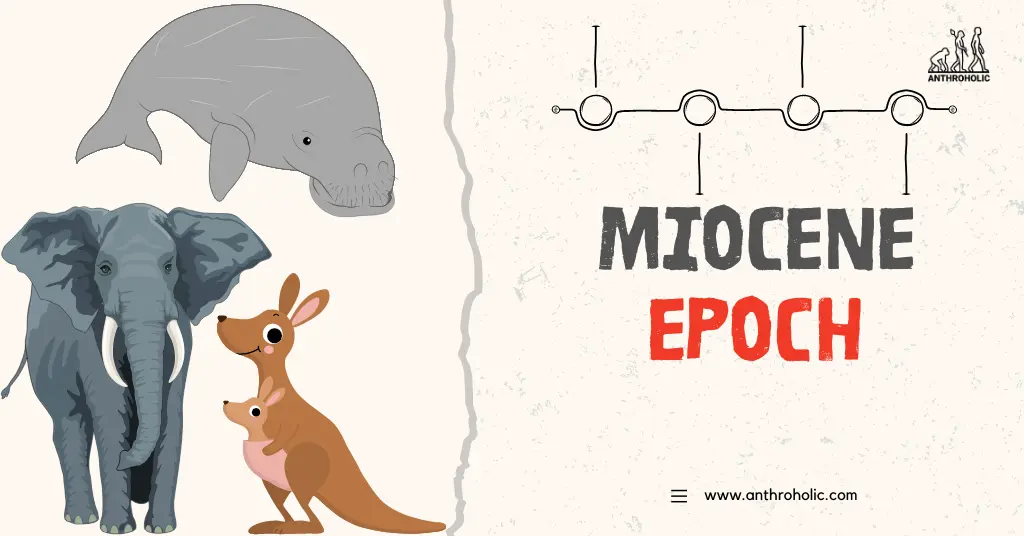AI Answer Evaluation Platform Live Now. Try Free Answer Evaluation Now
Miocene Epoch
The Miocene epoch, a significant period in Earth’s history, extended from about 23 million to 5.3 million years ago [1]. Characterized by drastic climate changes, the rise of new mammalian species, and the formation of new landscapes, the Miocene has left an indelible imprint on the planet.

Overview of the Miocene Epoch
A. Timeframe
The Miocene epoch is a part of the Neogene period and is divided into six age categories, spanning almost 18 million years [2]. The following table showcases these subdivisions, along with their corresponding timeframes:
| Age Category | Timeframe (Million Years Ago) |
|---|---|
| Aquitanian | 23.03 to 20.43 |
| Burdigalian | 20.43 to 15.97 |
| Langhian | 15.97 to 13.82 |
| Serravallian | 13.82 to 11.63 |
| Tortonian | 11.63 to 7.25 |
| Messinian | 7.25 to 5.33 |
B. Climate
The Miocene epoch witnessed major climate shifts. It began with a relatively warm phase, similar to the Oligocene epoch. This was followed by a cooling phase leading to the expansion of grasslands and a significant shift in the planet’s flora and fauna [2].
C. Geology
The geology of the Miocene epoch was defined by significant tectonic activity. The formation of the Himalayas and the Alps due to the collision of the African and Eurasian plates profoundly affected global climate patterns [3].
Flora and Fauna of the Miocene
A. Plant Life
The plant life during the Miocene epoch was influenced by the cooling and drying trend. The spread of grasslands fostered the evolution of grass-eating herbivores. The first known grasses, including the ancestors of corn and rice, appeared during this epoch [4].
B. Animal Life
The Miocene epoch saw the emergence and diversification of several mammalian groups:
- Carnivores: The epoch was marked by the rise of the first true cats and the diversification of canines [5].
- Herbivores: The rise of grasslands facilitated the evolution of large, grazing mammals, such as horses, camels, and deer [5].
- Primates: The epoch saw the first apes and Old World monkeys. The Miocene is also important in human evolutionary history, with the appearance of the first hominoids [6].
Notable Events of the Miocene Epoch
Two pivotal events characterize the Miocene Epoch:
- The Mid-Miocene Climatic Optimum (MMCO): This was a warm period that occurred around 15 million years ago, featuring temperatures higher than today’s [7].
- The Messinian Salinity Crisis (MSC): This event occurred around 6 million years ago, when the Mediterranean Sea partially dried up due to its isolation from the Atlantic Ocean [8].
Impact on Modern Biodiversity and Ecosystems
A. Origins of Modern Flora
The Miocene epoch significantly influenced the formation of modern ecosystems. In particular, the grasslands that proliferated in this epoch still form the basis for many ecosystems worldwide. These grasslands led to the evolution of grazing animals and the predators that fed on them, shaping the structure of modern terrestrial ecosystems [4].
B. Evolution of Marine Ecosystems
The Miocene also witnessed significant changes in marine ecosystems. The closing of the eastern Tethys Sea and the deepening of other seas promoted the diversification of marine mammals such as whales, dolphins, and seals. The fossil records from this epoch exhibit significant diversity among mollusks, indicating a period of rapid evolution due to changing marine environments [9].
Miocene in Pop Culture
The Miocene epoch, like other prehistoric periods, has been represented in various media, highlighting its fascinating wildlife and geological changes. Notably, the epoch was brought to life in the BBC’s “Walking with Beasts” series, which vividly portrayed the evolution of mammals during this period [10].
Ongoing Research and Exploration
The Miocene epoch remains a subject of extensive research due to its significant geological events and rich biodiversity. Various disciplines, including paleontology, geology, and climatology, continue to explore this epoch to further our understanding of Earth’s past and predict future climatic trends [11].
Conclusion
The Miocene epoch, characterized by dramatic climate changes, the evolution of mammals, and the formation of modern ecosystems, plays an instrumental role in our understanding of Earth’s history. Continued research on this epoch not only provides insights into the Earth’s past but also helps in forecasting future environmental changes.
References
[1] “Miocene Epoch”, Encyclopaedia Britannica [online], Available at: www.britannica.com/science/Miocene-Epoch [Accessed: July 23, 2023].
[2] Prothero, D.R. (2006). “After the Dinosaurs: The Age of Mammals”, Indiana University Press.
[3] Molnar, P., England, P., & Martinod, J. (1993). “Mantle Dynamics, Uplift of the Tibetan Plateau, and the Indian Monsoon”. Reviews of Geophysics, 31(4), 357-396.
[4] Strömberg, C.A. (2011). “Evolution of Grasses and Grassland Ecosystems”. Annual Review of Earth and Planetary Sciences, 39, 517-544.
[5] Werdelin, L., & Lewis, M.E. (2013). “Temporal Change in Functional Richness and Evenness in the Eastern African Plio-Pleistocene Carnivoran Guild”. PLoS ONE, 8(3), e57944.
[6] Begun, D.R. (2010). “Miocene Hominids and the Origins of the African Apes and Humans”. Annual Review of Anthropology, 39, 67-84.
[7] Zachos, J., Pagani, M., Sloan, L., Thomas, E., & Billups, K. (2001). “Trends, Rhythms, and Aberrations in Global Climate 65 Ma to Present”. Science, 292(5517), 686-693.
[8] Krijgsman, W., Hilgen, F.J., Raffi, I., Sierro, F.J., & Wilson, D.S. (1999). “Chronology, Causes and Progression of the Messinian Salinity Crisis”. Nature, 400(6745), 652-655.
[9] Harzhauser, M., & Piller, W.E. (2007). “Benchmark data of a changing sea — Palaeogeography, Palaeobiogeography and events in the Central Paratethys during the Miocene”, Palaeogeography, Palaeoclimatology, Palaeoecology, 253(1-2), 8-31.
[10] “Walking with Beasts”, BBC, [online] Available at: https://www.bbc.co.uk/programmes/b00tbkjh [Accessed: July 23, 2023].
[11] Zachos, J., Dickens, G.R., & Zeebe, R.E. (2008). “An early Cenozoic perspective on greenhouse warming and carbon-cycle dynamics”, Nature, 451(7176), 279-283.



